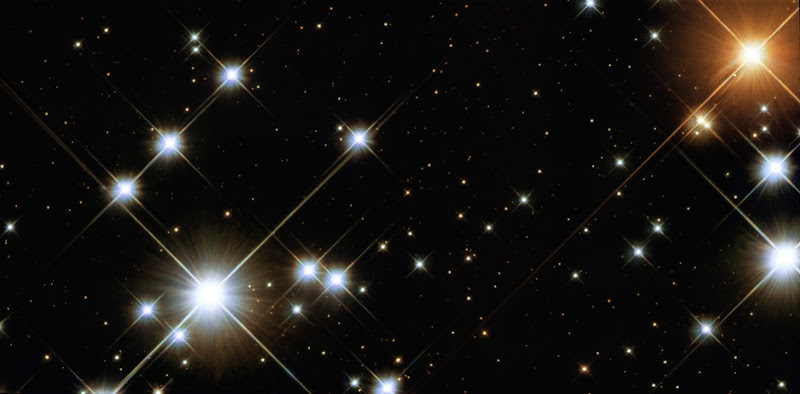
This composite image serves as a still "zoom-in", showing the rich star field in which NGC 4755 nestles and then moving in to the detailed Hubble image of the Kappa Crucis Cluster, or Jewel Box, itself. Credit: ESO, NASA/ESA, Digitized Sky Survey 2 and Jesús Maíz Apellániz (Instituto de Astrofísica de Andalucía, Spain)

This image is a "close-up' view from the NASA/ESA Hubble Space Telescope of NGC 4755, or the Jewel Box cluster. Several very bright, pale blue supergiant stars, a solitary ruby-red supergiant and a variety of other brilliantly coloured stars are visible in the image, as well as many much fainter ones, often with intriguing colours. The huge variety in brightness exists because the brighter stars are 15 to 20 times the mass of the Sun, while the dimmest stars are less than half the mass of the Sun. This is the first image of an open galactic cluster with imaging extending from the far ultraviolet to the near-infrared. Credit: NASA/ESA and Jesús Maíz Apellániz (Instituto de Astrofísica de Andalucía, Spain)

The FORS1 instrument on the ESO Very Large Telescope (VLT) at ESO's Paranal Observatory was used to take this exquisitely sharp close up view of the colourful Jewel Box cluster, NGC 4755. The telescopes huge mirror allowed very short exposure times: just 2.6 seconds through a blue filter, 1.3 seconds through a yellow/green filter and 1.3 seconds through a red filter. The field of view spans about seven arcminutes. Credit: ESO

This image of the well-known NGC 4755 cluster or Jewel Box was taken with the Wide Field Imager (WFI) on the MPG/ESO 2.2-metre telescope at ESO's La Silla Observatory. It highlights the cluster and its rich surroundings in all their multicoloured glory. The field of view is 20 arcminutes across. The picture is based on images obtained through B, V and I filters. Credit: ESO

A wide-field image of the region around NGC 4755 constructed from the data from Digitized Sky Survey 2. The bright star is Mimosa, one of the main four stars in the Southern Cross. The darkness towards the bottom of the image is part of the Coal Sack, a vast area of obscuring dust easily visible to the unaided eye. The field of view is approximately 2.8 degrees x 2.9 degrees. Credit: ESO, ESA/Hubble and Digitized Sky Survey 2. Acknowledgment: Davide De Martin (ESA/Hubble)


















